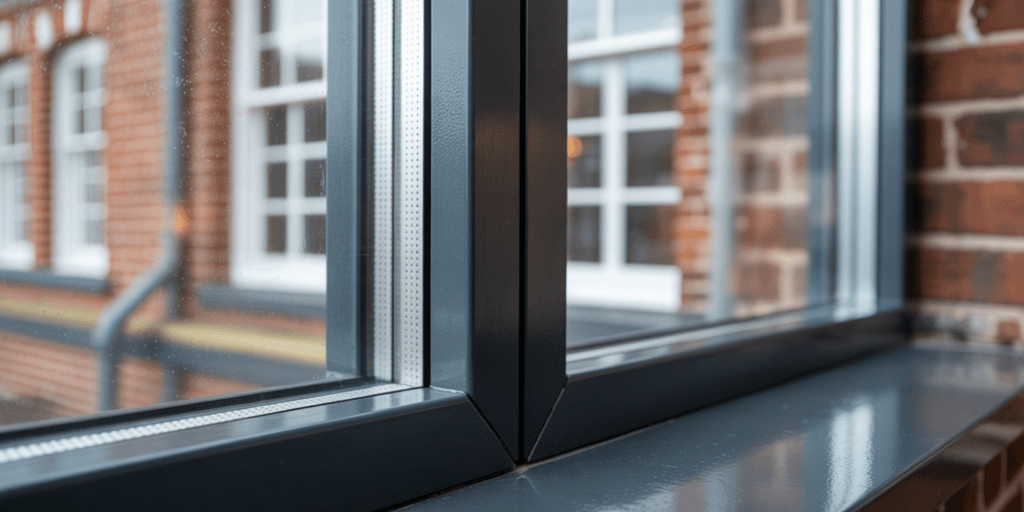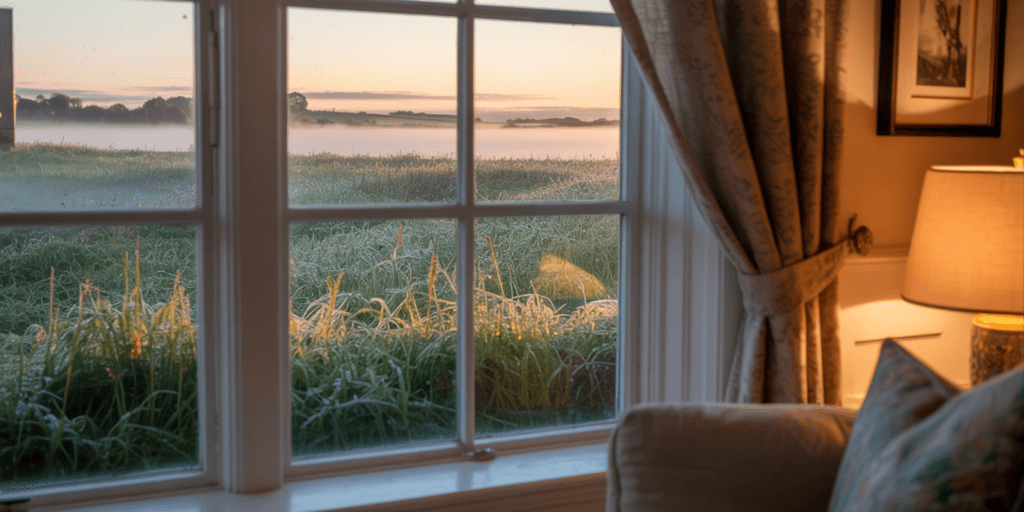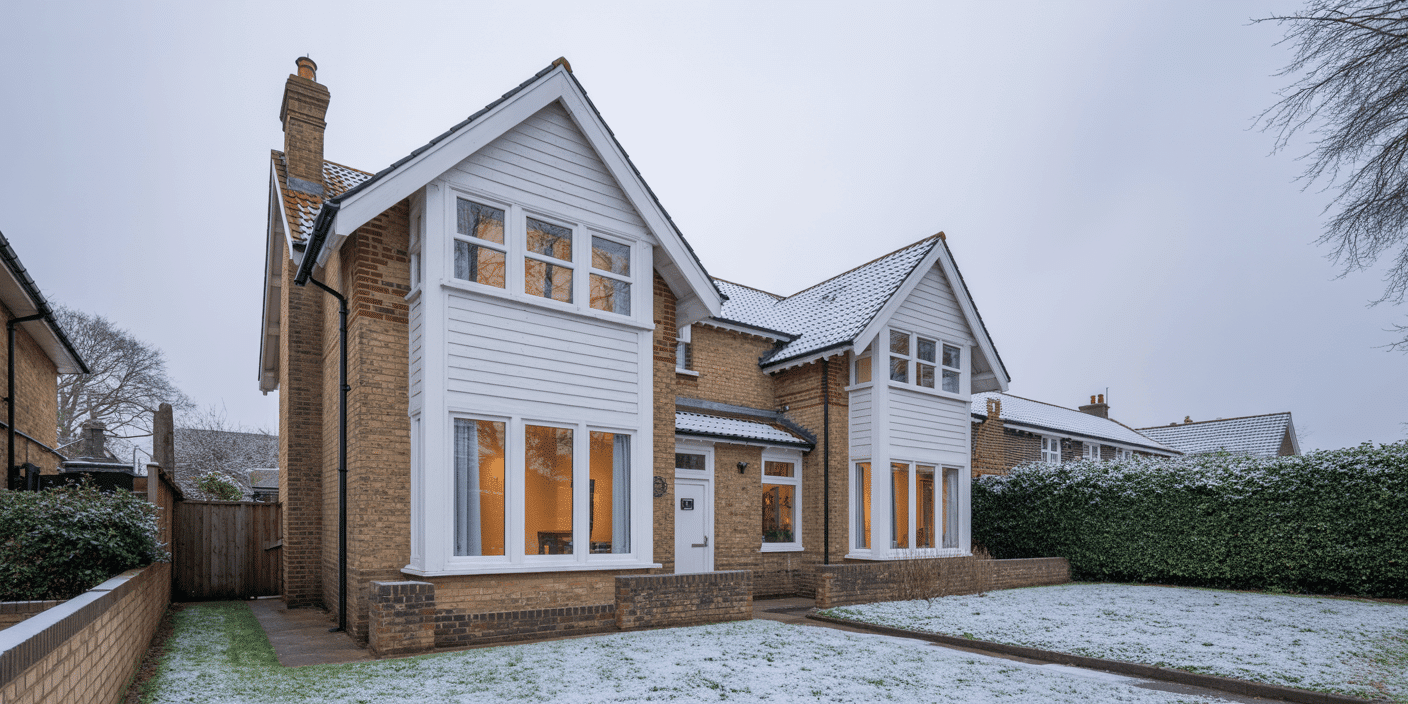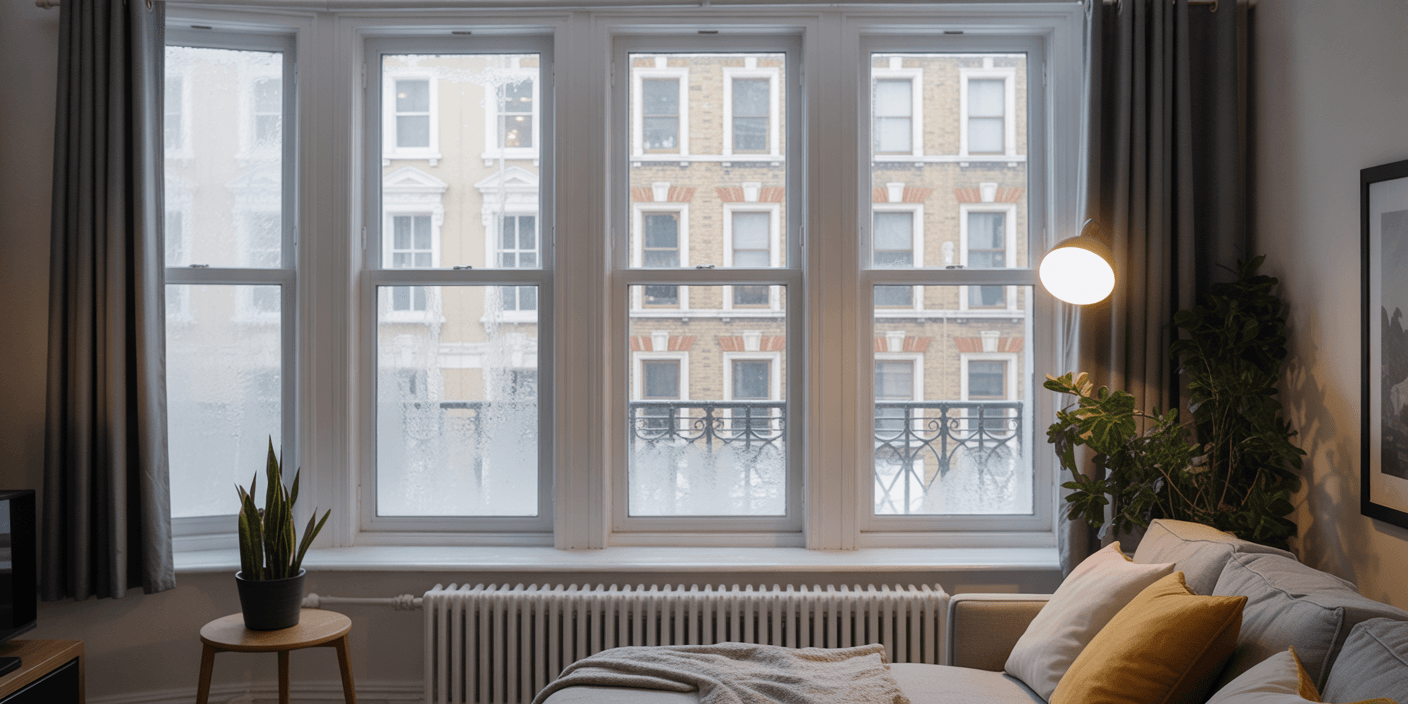The Invisible Leak: Why Your Home is Bleeding Heat
The signs are familiar.
A persistent chill in the hallway, long after the heating has stopped.
A room that never quite reaches temperature, even with modern double glazing.
The thermostat rises. The warmth does not stay.
Conventional wisdom places the blame on the glazing.
Triple panes, gas fills, and low-emissivity coatings have become the hallmarks of “energy efficiency.”
But the truth is simpler — and more uncomfortable:
Heat does not only escape through the glass. It escapes through the frame.
Imagine boiling water with the lid ajar. The heat disperses, despite the heat source.
This is precisely what’s happening in thousands of homes across Britain — particularly those fitted with heritage-style sash windows or new units designed without consideration for frame performance.
These frames — often uninsulated, poorly sealed, or thermally conductive — become bridges for energy loss.
They allow warmth to transfer directly through the structure, rendering even the most advanced glazing systems functionally compromised.
And yet, the industry continues to overlook the problem.
The vast majority of replacement windows on the market still rely on traditional frame construction — appearing modern, priced as premium, and yet performing no better than their predecessors.
The reality is clear:
It is not the pane that fails first. It is the frame.
For too long, the structural boundary surrounding the glass has been neglected — a collision point between centuries of architectural heritage and decades of under-engineering.
But that is changing.
A small number of firms began to ask a more fundamental question:
What if the frame was built to insulate as effectively as the glass?
That question redefined the standard.
Meet the Enemy: Standard Window Frames Unmasked
For decades, we accepted a quiet compromise.
Window frames were just… frames. A necessary structure to hold the glass. Nothing more.
And as long as they looked neat and didn’t rot, they passed inspection — even in high-end renovations.
But performance? That was left to the glazing.
Here’s what that oversight costs you.
Most standard frames — whether cheap uPVC or basic softwood — are built from solid, thermally conductive materials.
That means when it’s cold outside, the frame itself acts like a bridge, sucking warmth from the inside and releasing it into the atmosphere.
Your central heating works overtime. The result? Bills go up. Comfort goes down.
Even the so-called “modern” upgrades haven’t solved the issue.
Take standard double-glazed sashes in uPVC:
- Typical frame U-value: 1.6 to 2.8 W/m²K
- Poor air sealing around the sashes
- No thermal break in the frame structure
- Plastic expands and contracts with temperature shifts, allowing draughts
Timber frames — if untreated or unengineered — can suffer just as badly.
Moisture ingress, micro warping, seal degradation… all of it translates to heat loss you can’t see but absolutely feel.
And yet, these systems still dominate the market. Why? Because they’re easy. Because they’re cheap.
Because no one ever taught the frame to think.
Until now.
Because somewhere in South London, Sash Windows London was asking the harder questions.
Not “How do we sell more sashes?”
But: “How do we stop homes from leaking comfort at the structural level?”
They started with the frame — and they didn’t stop until it outperformed the glass.
Passive Windows: Engineering Built for the 21st Century

Not every solution shouts.
Some simply work — in silence, in stillness, in warmth you can feel but never see.
That’s the nature of passive windows.
They don’t sparkle with gimmicks. They don’t scream “new.”
They solve the problem at its root — by engineering the frame to finally do its job.
The Passive Difference Starts in the Structure
Where standard frames allow thermal bridging, passive window systems break the chain.
- Thermally broken frames — with insulating barriers built into the core
- Multi-layered seals — blocking draughts before they enter the conversation
- Low-conductivity materials — engineered to hold the heat in
- Frame Uw-values of 0.8 W/m²K or better — far outperforming the glazing they hold
And it’s not just theory. These are the very windows trusted by architects of Passivhaus-certified buildings, where performance isn’t optional — it’s the standard.
Passive windows don’t just meet Part L.
They laugh at it.
Where regulation demands compliance, passive frames exceed thermal benchmarks, reduce reliance on central heating, and improve the building’s EPC from day one.
Performance You Feel — and Never Have to Think About
But numbers don’t sell comfort. Experience does.
A passive window holds warmth the way a thermos holds tea.
It creates a stable, draft-free interior, even in Victorian townhouses or exposed rural cottages.
Condensation? Gone.
Cold corners? Erased.
Radiator overwork? A thing of the past.
And it happens without altering the way your home looks.
Because in the right hands — traditional joiners, heritage craftsmen — passive performance becomes invisible.
That’s the magic.
The Real Battlefield: Frames vs Glazing
If you’ve ever been told your windows would be “energy-efficient” because they had triple glazing, you’re not alone.
It’s the industry’s favourite distraction — and it’s only half the story.
Because here’s the uncomfortable truth:
Glass can’t save you if the frame is failing.
The Myth of “More Panes = More Performance”
Yes, triple glazing helps.
Yes, low-E coatings and gas fills do their part.
But too often, the entire conversation stops at the glazing unit, as if the frame is nothing but decorative trim.
And yet — that frame is responsible for up to 30% of total window heat loss.
Here’s why:
- Standard frames (uPVC, softwood, even aluminium without thermal breaks) conduct heat like radiator fins
- Gaps between sash and frame — particularly in older-style windows — act like chimneys for warm air
- Poor sealing allows not just heat loss, but noise and moisture ingress
Even a premium glass unit can’t compensate for that kind of structural vulnerability.
The Frame is the True Engine of Comfort
Passive window frames are designed with thermal science, not just joinery.
- Every internal chamber, gasket, and seal exists to interrupt thermal transfer
- Precision-machined tolerances eliminate micro draughts
- Compression seals respond to temperature fluctuation, maintaining airtight performance all year round
- Laminated materials (timber + composite + alu-clad) block both heat and sound — quietly
It’s not just warmer.
It’s quieter.
It’s drier.
It’s simpler to live in.
And it works just as elegantly in a Georgian terrace as it does in a new eco-home — especially when executed by teams who understand both heritage and performance.
So, Why Has the Industry Ignored the Frame?
Because it’s harder.
It’s easier to sell glass specs. Easier to point to U-values on brochures. Easier to keep replacing the same system over and over again, without ever fixing the structure.
But some companies didn’t take the easy route.
Some realised that if the frame fails, the whole system fails — and designed their windows to eliminate that risk entirely.
Some asked better questions.
Some listened to what the cold rooms were really saying.
Performance in Disguise: How Passive Frames Preserve Period Beauty
Heritage homeowners face a dilemma.
They want warmth, comfort, and efficiency — but they refuse to sacrifice the character of their home to get it.
And rightly so.
Because your sash windows aren’t just holes in the wall — they’re historical artefacts, architectural signatures, the very rhythm of the façade.
Plastic impostors or clunky modern frames? They ruin the composition.
But being cold shouldn’t be the price of preserving beauty.
That’s where passive window design — in the right hands — becomes an invisible revolution.
Built Like the Past, Engineered for the Future
Thanks to composite frame engineering, alu-clad timber profiles, and bespoke joinery, it’s now possible to deliver full passive performance in frames that match original sightlines, profiles, horn details and putty lines.
Sash Windows London has mastered this intersection:
- Slimline frames with heritage shadow gaps
- Custom horn profiles to suit Georgian, Victorian, or Edwardian aesthetics
- Timber exteriors with alu-clad internal structure — giving durability and efficiency, without visual compromise
- Glazing bars, sash cords, and period mouldings — all retained
To the eye? It’s still the same elegant window.
To the building? It’s an energy upgrade that can cut heat loss by over 60%.
To conservation officers? It’s compliant, reversible, and sympathetic to the original design.
From Planning Permission to Passive Perfection
In conservation areas and listed properties, window upgrades are notoriously tricky.
But with passive frames styled to match heritage typologies — and documented U-values, thermal performance, and acoustic data — planners now view them as allies, not intrusions.
Sash Windows London has guided clients through the paperwork, the site visits, the assessments — and delivered invisible upgrades that passed both the thermal test and the aesthetic one.
“They look exactly the same… until you realise you don’t need slippers anymore.”
The charm remains. The cold doesn’t.
And no one on your street will know the difference — unless they notice you haven’t complained about draughts all winter.
Counting the Cost: Standard vs Passive Over 10 Years

Let’s do something most window quotes never invite you to do:
Add it all up.
Because the question isn’t, “How much do passive windows cost today?”
The question is, “What do standard windows cost you over 10 years?”
The Real Price of Standard Frames
Most “affordable” window options are exactly that — short-term affordability hiding long-term liability.
- Heat loss through frames can account for 25–30% of total window inefficiency
- An average UK home loses £300–£600/year in heating inefficiency through poor fenestration
- Over 10 years? That’s £3,000–£6,000 burned, without even counting inflation
- Add repairs, repainting, draught sealing, and condensation damage, and you’re looking at ongoing hidden costs that spiral quietly
Now pair that with the fact that cheap windows degrade faster — warping, shrinking, expanding — and you’re likely replacing or refurbishing them before the decade’s out.
Standard isn’t cheap. It’s just… delayed and expensive.
What Passive Windows Actually Save You
Passive window systems flip the economics.
- U-values ≤ 0.8 W/m²K mean minimal thermal leakage
- Frames designed to last 30–40+ years with low maintenance
- Stable indoor temperatures mean your boiler, radiator, and underfloor heating systems work less
- No mould. No draught-proofing DIY. No, “just put on another jumper.”
- And perhaps most valuably: a noticeable boost to your property’s EPC rating, often by an entire grade — unlocking mortgage advantages, higher resale value, and compliance confidence for the next 10–20 years
All from the frame.
Lifetime Logic: An ROI, Not a Luxury
Passive windows are not an expense.
They are a capital upgrade to the thermal shell of your home.
One that improves comfort immediately — and continues delivering value forever.
Sash Windows London installs passive frames not because it’s fashionable — but because it’s the only honest long-term solution for homes that want to stay beautiful and warm.
And if you’re spending thousands to heat a house through outdated frames, there’s only one question left:
Would you rather pay the builder once or your energy company forever?
The Frame That Pays You Back
You never buy windows because you want windows.
You buy them because you want what windows give you:
Warmth. Silence. Stillness. Pride.
And the right frame gives it all — quietly.
The Invisible Upgrade You’ll Notice Every Day
A passive frame doesn’t make noise.
It doesn’t draw attention.
It simply removes the friction between you and the comfort you thought you’d already paid for.
- That cold corner by the bay window? Gone.
- The hallway that needed its own radiator? Balanced.
- The condensation that ate your paintwork? Erased.
- That “chill you could never quite explain”? Now explained — and eliminated.
It’s not louder. It’s not flashier.
It’s just… better.
And once you’ve lived with it, anything else feels broken.
Beauty Meets Peace
These frames don’t ask you to choose between character and performance.
They look like heritage.
They perform like tomorrow.
They blend into Georgian terraces, Edwardian semis, Victorian villas — and make them feel modern, without losing an ounce of soul.
They’re built by craftsmen who obsess over horn details, sash lines, and historic proportions — while embedding 21st-century performance within every seal and join.
It’s not style versus substance. It’s both, perfectly executed.
This Is Why You Called
You didn’t come looking for jargon.
You came looking for a solution that felt right — that didn’t feel like a compromise.
And now you know: it starts with the frame.
Not the marketing slogans.
Not the triple glazing.
Not the “cheapest quote wins.”
But with a window system designed to hold heat, hold silence, and hold its beauty for decades.
Sash Windows London didn’t invent the idea of comfort.
They just engineered it into the place most people forgot to look.
The Warmest Decision You’ll Ever Make
By now, you’ve likely realised something:
It was never just about the window.
It was always about what stood between you and comfort — literally.
And now, you know where the change begins:
With the frame.
So here’s the simplest next step — no jargon, no pressure, no obligation.
Apply for Your Passive Frame Consultation
This isn’t a sales visit.
It’s a conversation — one that starts with your home, your needs, and your coldest room.
We’ll help you understand:
- Where heat is being lost
- What’s actually behind that condensation
- How to meet performance standards without breaking character or planning rules
- And what kind of frame would change everything — quietly
You’ll walk away with a tailored Passive Frame Report:
A short, clear document showing what’s possible, what it saves, and how it looks — for your property.
The Only Time You’ll Ever Think About Your Windows Again
Because when it’s done right, you don’t notice your windows.
You notice what they give you:
- Rooms that hold their heat
- A home that feels still and silent
- Bills that stop rising
- Frames that never demand your attention
- And a decision you never have to second-guess
📍 Request your consultation today.
It’s not a pitch.
It’s a warm start.







